Manduca lanuginosa
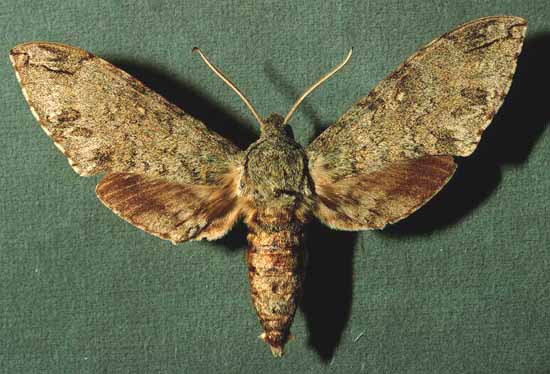
Manduca lanuginosa male courtesy of Dan Janzen.
This site has been created by
Bill Oehlke at oehlkew@islandtelecom.com
Comments, suggestions and/or additional information are welcomed by Bill.
TAXONOMY:
Family: Sphingidae, Latreille, 1802
Subfamily: Sphinginae, Latreille, [1802]
Tribe: Sphingini, Latreille, 1802
Genus: Manduca Hubner, 1807 ...........
Species: lanuginosa H. Edwards, 1887
|
MIDI MUSIC
.....It's a Wonderful World.....
copyright C. Odenkirk
ON.OFF
<bgsound src="world.mid" LOOP=FOREVER>
|
DISTRIBUTION:
Manduca lanuginosa (Wing span: males: 86-102mm; females: 104-110mm),
flies in
Mexico (specimen type locality);
Belize: Corozol, Orange Walk, Cayo, Stann Creek, Toledo;
Honduras;
Nicaragua: and
Costa Rica: Guanacaste. It has also been taken in Venezuela, and it might be present in
Colombia.
The adult is easily distinguished from any other species of Sphingidae that occurs in Costa Rica. The combination of
not having yellow spots on the sides of the abdomen, not having a white dot in the center of the forewing, having gray
shoulders, and having a diffuse gray-brown "patternless" wing color does not occur on any other species of Costa
Rican sphingid. However, the background color of the wings and their texture does vary from quite dark brown to quite light gray.
This species is duller, with more uniform colouration than Manduca florestan.
The side spots on the abdomen contain less black than in Manduca florestan.
The most superficially similar species are Manduca dilucida, Manduca florestan, and Manduca
barnesi.
In Costa Rica, adults of M. lanuginosa are known only from dry forest on the Pacific side from
the Area de Conservacion Pacifico Central to the north. However, it will not be surprising if they are eventually found in
the remains of the dry forest in the Valle del Rio General and in the vicinity of Boruca, since M. lanuginosa is
one of the four Costa Rican Manduca that occur only in dry forest (together with Manduca dilucida, Manduca
barnesi, and Manduca muscosa.
FLIGHT TIMES:
Manduca lanuginosa adults fly as a single brood in Costa Rica with adults
on the wing with the onset of the rainy season in May to June.
ECLOSION:
Pupae probably wiggle to surface from subterranean chambers just prior to eclosion.
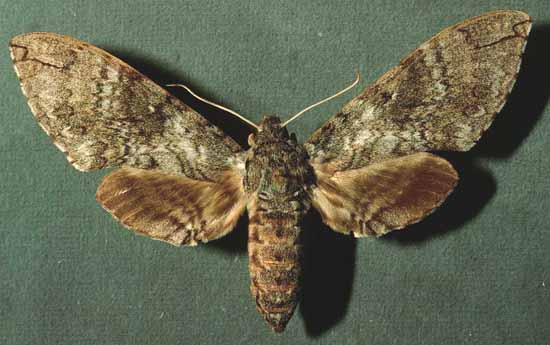
Manduca lanuginosa female courtesy of
Dan Janzen.
SCENTING AND MATING:
Females call in the males with a pheromone released from a gland at the tip of the
abdomen. Adults take nectar from flowers that open at night like Calliandra marginata.
EGGS, LARVAE, PUPAE:
Larvae feed on Cydista heterophylla, Arrabidaea chica,
Arrabidaea molissima, Crescentia alata, Cydista diversifolia, Tabebuia ochracea, and on Macfadyena unguis-cati
of the Bignoniaceae family. They also feed onCornutia grandifolia and on Rehdera trinervis of the Verbenaceae family.
The middle-sized, white stripes are not so prominent as in Manduca florestan.
The larva of
Manduca lanuginosa is among the most distinctive larvae of Sphingidae known in Costa Rica,
because the diagonal lateral white slashes continue up onto the back in the form of lines of small black rings with
white centers, producing the impression of rows of white dots. There is no other sphingid larva known from Costa Rica
with which this larva can be confused.
The background color of M. lanuginosa larvae can be green,
yellow-green with purpose or black-purple.
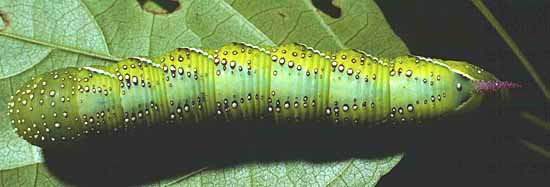
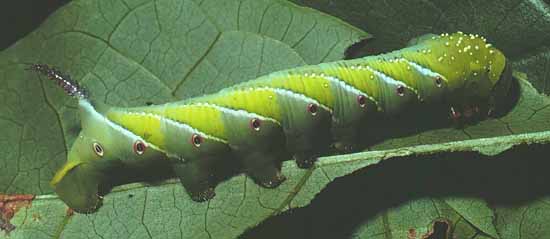
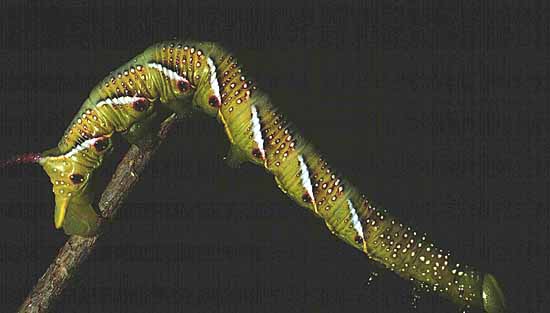
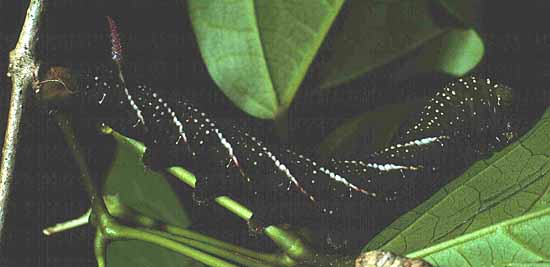
Sometimes this species will remain in pupa stage for six weeks, but often larvae that pupate in
June emerge the following May.The pupa of Manduca lanuginosa has a ventrally curved tongue case that is typical
of Manduca, but the case is exceptionally short and quite inflated at the tip. |
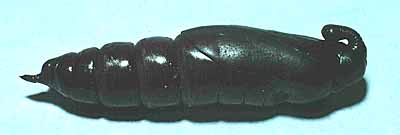 |
The prepupal larva mines 3-10 cm deep into the soil and
excavates a chamber for the pupa and then pupates in 4-5 days. The pupal cuticle is thick, hard and black. The pupa
remains dormant until the beginning of the next rainy season (10-11 months later).
Return to Sphingidae Index
Return to Sphingini Tribe
Use your browser "Back" button to return to the previous page.
This page is brought to you by
Bill Oehlke and the
WLSS. Pages are on space rented from Bizland. If you would like
to become a "Patron of the Sphingidae Site", contact Bill.
Please send sightings/images to Bill. I will do my best to respond to
requests for identification help.
Enjoy one of nature's wonderments: Live Saturniidae (Giant Silkmoth) cocoons.
 | 
Show appreciation for this site by clicking on flashing butterfly to the left.
The link will take you to a page with links to many insect sites. |








